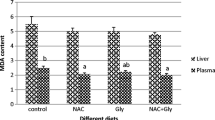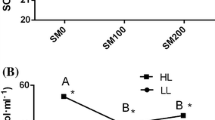Abstract
Thymol is an herbal food additive used to improve animal performance. Thymol acts via its potential to enhance productive and reproductive performance, and by improving bioavailability of nutrients in fish. Nevertheless, the exact mechanisms associated with these phenomena remain poorly understood, although recent evidence has suggested the involvement of the phosphotransfer network and antioxidant status. Therefore, the aim of this study was to determine whether the improvement of the antioxidant/oxidant status and the phosphoryl transfer network may be involved in enhanced growth performance in grass carp (Ctenopharyngodon idella) fed with various levels of thymol (100, 200, and 300 mg/kg feed). Thymol-supplementation (100 mg/kg feed) produced higher body weight and weight gain for 60-day post-feeding compared to the control group. Specific growth rate was higher; while feed conversion ratio was lower in fish that consumed 100 mg of thymol/kg compared to other groups. Hepatic lactate dehydrogenase activity and lipid peroxidation levels were lower in the thymol-supplemented group (100 mg/kg feed) than in the control group, while reactive oxygen species were lower in all supplemented groups than in the control group. Hepatic superoxide dismutase (300 mg/kg feed) and glutathione peroxidase (100, 200, and 300 mg/kg feed) activities, as well as antioxidant capacity against peroxyl radicals (100 mg/kg feed) were higher in these groups than in the control group. Based on these data, we conclude that 100 mg thymol/kg dietary supplementation increased growth performance of fingerling grass carp. Finally, hepatic adenylate kinase activity was lower in the thymol supplemented group (100 mg/kg feed) than in the control group. Thymol supplementation (100 mg/kg feed) improved hepatic energy metabolism, while practically all tested concentrations of thymol enhanced hepatic antioxidant status, all of which may be pathways involved in increased growth performance in fingerling grass carp.



Similar content being viewed by others
References
Ahmadifar E, Falahatkar B, Akrami R (2011) Effects of dietary thymol-carvacrol on growth performance, hematological parameters and tissue composition of juvenile rainbow trout, Oncorhynchus mykiss. J Appl Ichthyol 27:1057–1060
Amado LL, Garcia ML, Ramos PB, Freitas RF, Zafalon B, Ferreira JL, Yunes JS, Monserrat JM (2009) A method to measure total antioxidant capacity against peroxyl radicals in aquatic organisms: application to evaluate microcystins toxicity. Sci Total Environ 407:2115–2123
Amer SA, Metwally AE, Ahmed SAA (2018) The influence of dietary supplementation of cinnamaldehyde and thymol on the growth performance, immunity and antioxidant status of monosex Nile tilapia fingerlings (Oreochromis niloticus). Egyp J Aqua Res 44:251–256
Anyu M, Betancor MB, Monroig O (2018) Effects of dietary limonene and thymol on the growth and nutritional physiology of Nile tilapia (Oreochromis niloticus). Aquaculture 488:217–226
Baldissera MD, Souza CF, Baldisserotto B, Zimmer F, Paiano D, Petrolli TG, Da Silva AS (2019) Vegetable choline improves growth performance, energetic metabolism, and antioxidant capacity of fingerling Nile tilapia (Oreochromis niloticus). Aquaculture 501:224–229
Bento MHL, Ouwehand AC, Tiihonen K, Lahtinen S, Nurminen S, Saarinen MT, Schulze H, Mygind T, Fischer J (2013) Essential oils and their use in animal feeds for monogastric animals - Effects on feed quality, gut microbiota, growth performance and food safety: a review. Vet Med 58:449–458
Bianchini AE, Garlet Q, Da Cunha JA, Bandeira Junior G, Brusque ICM, Salbego J, Heinzmann BM, Baldisserotto B (2017) Monoterpenoids (Thymol, carvacrol and S-(+)-linalool) with anesthetic activity in silver catfish (Rhamdia quelen): Evaluation of acetylcholinesterase and GABaergic activity. Braz J Med Biol Res 50:e6346
Biazus AH, Da Silva AS, Bottari NB, Baldissera MD, do Carmo GM, Morsch VM, Schetinger MRC, Casagrande R, Guarda NS, Moresco RN, Stefani LM, Campigotto G, Boiago MM (2017) Fowl typhoid in laying hens cause hepatic oxidative stress. Microb Pathog 103:162–166
Da Cunha JA, Bandeira Junior G, da Silva EG, De Ávila Scheeren C, Fausto VP, Salbego J, De Almeida Vaucher R, de Vargas AC, Baldisserotto B (2019) The survival and hepatic and muscle glucose and lactate levels of Rhamdia quelen inoculated with Aeromonas hydrophila and treated with terpinen-4-ol, carvacrol or thymol. Microb Pathog 127:220–224
Dzeja PP, Terzic A (2003) Phosphotransfer networks and cellular energetics. J Exp Biol 206:2039–2047. https://doi.org/10.1242/jeb.00426
Dzeja P, Terzic A (2009) Adenylate kinase and AMP signaling networks: metabolic monitoring, signal communication and body energy sensing. Int J Mol Sci 10:1729–1772
Dzeja PP, Vitkevicius KT, Redfield MM, Burnett JC, Terzic A (1999) Adenylate kinase-catalyzed phosphotransfer in the myocardium: increased contribution in heart failure. Circ Res 84:1137–1143
El-Hack MEA, Alagawany M, Farag MR, Tiwari R, Karthik K, Dhama K, Zorriehzahra J, Adel M (2016) Beneficial impacts of thymol essential oil on health and production of animals, fish and poultry: a review. J Essent Oil Res 28:365–382
FAO (2018) The state of world fisheries and aquaculture: meeting the sustainable development goals. Food and Agriculture Organization of the United Nations, Rome
Galloway ML, Kilambi RV (1984) Temperature preference and tolerance of grass carp (Ctenopharyngodon idella). J Arkansas Acad Sci 38:11
Giannenas I, Triantafillou E, Stavrakakis S, Margaroni M, Mavridis S, Steiner T, Karagouni E (2012) Assessment of dietary supplementation with carvacrol or thymol containing feed additives on performance, intestinal microbiota and antioxidant status of rainbow trout (Oncorhynchus mykiss). Aquaculture 350-353:26–32
Grings M, Parmeggiani B, Moura, AP, De Moura AL, Wyse, ATS, Wajner, M, Leipnitz, G (2018) Evidence that thiosulfate inhibits creatine kinase activity in rat striatum via thiol group oxidation. Neurotox Res 34:693–705
Habig WH, Pabst MJ, Jakoby WB (1974) Glutathione S transferases. The first enzymatic step in mercapturic acid formation. J Biol Chem 249:7130–7139
Hoseini SM, Yousefi M (2019) Beneficial effects of thyme (Thymus vulgaris) extract on oxytetracycline-induced stress response, immunosuppression, oxidative stress and enzymatic changes in rainbow trout (Oncorhynchus mykiss). Aquac Nutr 25:298–309
Kaplan A, Szabo LL, Opheim KE (1998) Clinical chemistry: interpretation and techniques. Lea e Febiger, Philadelphia
Kwiecien S, Jasnos K, Magierowski M, Sliwoeski S, Pajdo R, Brzozowski B, Match T, Wojcik D, Brzozowski T (2014) Lipid peroxidation, reactive oxygen species and antioxidative factors in the pathogenesis of gastric mucosal lesions and mechanism of protection against oxidative stress - induced gastric injury. J Physiol Pharmacol 65:613–622
LeBel CP, Ischiropoulos H, Bondy SC (1992) Evaluation of the probe 2',7'-dichlorofluorescin as an indicator of reactive oxygen species formation and oxidative stress. Chem Res Toxicol 5:227–231
Leong SF, Lai JC, Lim L, Clark JB (1981) Energy-metabolizing enzymes in brain regions of adult and aging rats. J Neurochem 37:1548–1556
Marinho RGB, Tavares-Dias M, Dias-Grigório MKR, Neves LR, Yoshioka ETO, Boijink CL, Takemoto RM (2013) Helminthes and protozoan of farmed pirarucu (Arapaima gigas) in eastern Amazon and host-parasite relationship. Arq Bras Med Vet Zootec 65:1192–1202
Marklund S, Marklund G (1974) Involvement of the superoxide anion radical in the autoxidation of pyrogallol and a convenient assay for superoxide dismutase. Eur J Biochem 47:469–474
Montserrat JM, Geracitano LA, Pinho GLL, Vinagre VM et al (2003) Determination of lipid peroxides in invertebrates using the Fe (III) xylenol orange complex formation. Arch Environ Contam Toxicol 45:177–183
National Research Council (2011) Nutrient Requirements of Fish and Shrimp. The National Academies Press, Washington, DC. https://doi.org/10.17226/13039
Paglia DE, Valentine WN (1967) Studies on the quantitative and qualitative characterization of erythrocytes glutathione peroxidase. J Lab Clin Med 70:158–169
Ran C, Hu J, Liu W, Liu Z, He S, Truc DBC, Diem NN, Ooi EL, Zhou Z (2016) Thymol and carvacrol affect hybrid tilapia through the combination of direct stimulation and an intestinal microbiota-mediated effect: insights from a germ-free zebrafish model. J Nutr 146:1132–1140
Read SM, Northcote DH (1981) Minimization of variation in the response to different proteins of the Coomassie blue G dye-binding assay for protein. Anal Biochem 116:53–64
Ribeiro PAP, Miranda-Filho C, De Melo DC, Luz RK (2015) Efficiency of eugenol as anesthetic for the early life stages of Nile tilapia (Oreochromis niloticus). Ann Braz Acad Sci 87:529–535
Souza CF, Baldissera MD, Descovi SN, Zeppenfeld CC et al (2018) Serum and hepatic oxidative damage induced by a diet contaminated with fungal mycotoxin in freshwater silver catfish Rhamdia quelen: Involvement on disease pathogenesis. Microb Pathog 124:82–88
Verdouw H, Vanechteld CJA, Deckkers EMJ (1978) Ammonia determinations based on indophenol formation with sodium salicylate. Water Res 12:399–402
Wang H, Chu W, Das SK, Ren Q (2002) Liver pyruvate kinase polymorphisms are associated with type 2 diabetes in Northern European Caucasians. Diabetes 51:2861–2865
Yousefi M, Hoseini SM, Vatnikov YA, Nikishov AA, Kulikov EV (2018) Thymol as a new anaesthetic in common carp (Cyprinus carpio): efficacy and physiological effects in comparison with eugenol. Aquaculture 495:376–383
Zheng ZL, Tan JYW, Liu HY, Zhou XH, Xiang X, Wang KY (2009) Evaluation of oregano essential oil (Origanum heracleoticum L.) on growth, antioxidant effect and resistance against Aeromonas hydrophila in channel catfish (Ictalurus punctatus). Aquaculture 292:214–218
Statement: expects data
The data that support the findings of this study are available from the corresponding author upon reasonable request.
Funding
CAPES and CNPq financially supported the scholarship and research (PQ).
Author information
Authors and Affiliations
Corresponding author
Ethics declarations
Ethics committee
These experiments were approved by the Animal Welfare Committee of the State University of Santa Catarina (UDESC) under protocol number 8817050418.
Conflict of interest
The authors declare that they have no conflict of interest.
Additional information
Publisher’s note
Springer Nature remains neutral with regard to jurisdictional claims in published maps and institutional affiliations.
Highlight
• Thymol is an herbal food additive used to improve animal performance.
• Dose of 100 mg thymol/kg dietary supplementation tested in the present study increased the weight gain of fingerlings of grass carp under non-ideal conditions.
• Thymol dietary supplementation (100 mg/kg feed) was able to improve the hepatic energy metabolism.
• Thymol in diet enhanced the hepatic antioxidant status, which can be pathways involved in the increase of growth performance of fingerlings grass carp.
Rights and permissions
About this article
Cite this article
Morselli, M.B., Reis, J.H., Baldissera, M.D. et al. Benefits of thymol supplementation on performance, the hepatic antioxidant system, and energetic metabolism in grass carp. Fish Physiol Biochem 46, 305–314 (2020). https://doi.org/10.1007/s10695-019-00718-2
Received:
Accepted:
Published:
Issue Date:
DOI: https://doi.org/10.1007/s10695-019-00718-2




